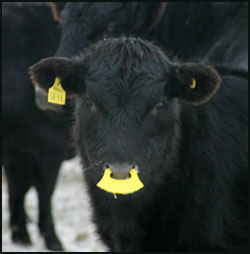Weaning Calves with Nose Flaps
Wyoming producer says process was less stressful
on the calves and him.
There are many ways to wean calves. The ultimate goal is to wean with the least stress — to keep calves healthy and keep them gaining.
Andy Gray, who grazes 500 cows near Douglas, Wyo., last year tried a new weaning method, using nose flaps on the calves. These plastic flaps can be easily installed with the calves restrained in a chute. Afterward, the calves are returned to their mothers. The flap hangs down over their nose and mouth, preventing the calf from grabbing a teat to nurse. The nose flaps don't hinder eating grass or hay or drinking water.
The calf can't nurse, but it is not worried because it is still with its mama and has her companionship during the weaning process. The cow starts to dry up, and the calf adjusts to not having milk. A few days later, cows and calves can be separated from one another, and the flaps can be removed.
Gray tried this with 100 calves last year and says it's a good way to wean.
"Out of 100 head, about four flaps came out, but it worked really well on the rest. We left the flaps in for a week, then took them out and put the calves in another pasture," he says. This creates very little stress on calves and cows.
"It was also less stressful for me," he adds. "They weren't bawling or trying to get through fences. We just put the calves through the chute to install the nose flaps, then turned them all back out in our summer pasture."
Gray says he didn't pay much attention to the pairs as they were being weaned, which made the weaning process easier on him.
"When we rounded them up later and took the nose flaps out. None of them were bawling, and they were definitely weaned. It was the simplest, easiest way we've ever weaned calves."
The calves then went to irrigated pasture and went right to grazing, he says. The cows were put on another pasture.
"We plan to use the nose flaps again. It worked well, being able to turn the pairs back out and forget about them, and then round them up again in a week to separate them," Gray says. Some producers give the calves their vaccinations at the same time they are installing the flaps or taking them out.
"The flaps are easy to put in, easy to remove and reusable from year to year. Compared with traditional weaning — keeping them in a corral breathing dust — or even fenceline weaning, I prefer to leave them out on the pasture with their mothers," he says.












